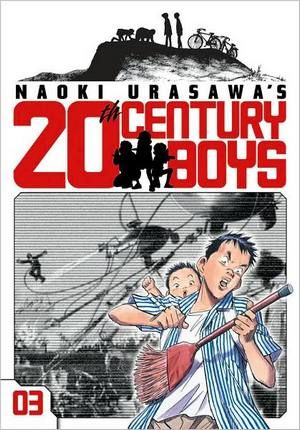Naoki Urasawa is a legendary talent in Japanese Manga whose work has spanned from a reinterpretation of the timeless classic "Astro Boy" in "Pluto" to the noir murder mystery "Monster." Those works are easily identifiable and straightforward. "20th Century Boys," possibly his best work, is not.
It's ostensibly the story of Kenji, a hardscrabble shopkeep in the family convenience store, stuck taking care of his missing sister's baby and working tirelessly with his thankless Mother, every day. While the scope does indeed venture far beyond those roots -- into robot invasions and deadly cults -- it is a series remarkably grounded in the mundane details of Kenji's increasingly complicated life. As much as his all-slowly-coming-back-to-him childhood is directly related to a cult led by someone known only as Friend that is building up a fearsome body count, Urasawa never lets the narrative stray too far from the day-to-day life of Kenji or any number of other people tied into the cult or its victims. It's this verisimilitude that raises the book far above other suspense stories.
That being said, it is an incredibly driven page turner. The identity of the Friend is still a bit of a mystery, and Urasawa is almost gleefully cruel in keeping his identity from us in this installment. While we're left guessing, there are still plenty of revelations in nearly every chapter. There are murders, mass murders, airport bombings, paternity bombshells, even a spot of Muay Thai fighting near the end.
But really, this is a story about Kenji taking control of his own life, balancing his responsibilities with the drive and independence he used to have in his life. This is all perfectly manifested in his old guitar, collecting dust in the back of his closet. After two volumes of trepidation and adherence to the status quo in his life, he's finally decided to get back in touch with the man he used to be, and he wakes up the whole neighborhood doing it. It's a key moment in the series so far, as we learn that his sister got him the guitar in the first place. He decides that he will embrace the destiny that seems to be before him and, from there, a story that has focused more on the mundane stillness of his life, picks up the pace dramatically.
Technically, this book suffers the same fate of a lot of manga, production-wise. Since Japanese text is read and written vertically, it often leaves English letterers with very little room to work with when it comes to placing translated dialogue. More often then not, this leads to uninspired and generic looking lettering. Very little care is given to making the type flow well with the artwork and even though it appears like letterer Freeman Wong attempted to use different typefaces for different situational dialogue, it still locks a coherent direction. It's certainly small gripe, and most people won't even notice it, but when a book is as smartly designed as this book is on the outside (and it really is a phenomenally designed book) it's disappointing when the interiors don't display the same care and attention.
The volume ends with a small but thematically resonant revelation. A stranger (whose identity is almost comically obvious) comes across the manga compendiums of his youth and is amused to find they still use the same symbol to signal a story's continuing on the following page. The reader instantly recognizes it as a key component of the symbol of the Friend's cult. While on the surface, it's another clever tie between Kenji's childhood and the reality being put forth by the cult, symbolically it perfectly encapsulates the main idea of the novel. These sudden developments in Kenji's life are finally, and literally, guiding him to "What's Next." This is ultimately a story about the stray hopes and dreams of adventure, in this story personified by comics themselves, that every now and then end up building the adult that our childhood selves always dreamed of being.

